Bahiga Hafez
(1908- 1983)
she was the producer, actor, editor, costume designer and music composer of The Victims.
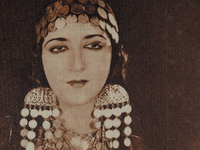
Bahiga Hafez
(1908- 1983)
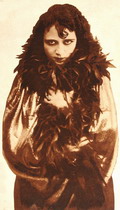
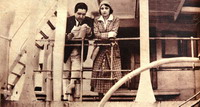
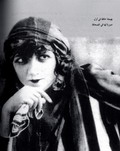
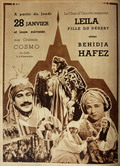
Despite the fact that at the beginning of the twentieth century women were still relegated to an inferior position in Egypt, Egyptian cinema was founded in the twenties by pioneering women who were kindled by a strong desire to develop a national film industry. Among those women was the Alexandrian Bahiga Hafez, a talented woman who ventured into the field of cinema, despite overwhelming odds, to not only act but also direct, produce, edit, design the costumes and compose the sound track of her films, hence emerging as one of the pioneers of Egyptian cinema.
Bahiga was born on 4th August 1908 to a respectable and well-established Alexandrian aristocratic family. She enjoyed and benefited from that immensely privileged background: she came to master, apart from Arabic, English, French and Italian, thanks to the education she received in language schools and the cosmopolitan spirit of Alexandria at that time. She was also taught music at a very early age and learned to appreciate the arts as she was brought up in an artistic milieu created by her father who was a patron of the arts and encouraged promising young artists, among whom were Abdel Hai Helmi and Abdou el Hamouli, at his house in Moharrem Bey.
She got married at a young age, as was customary at that time, to an Iranian prince. This premature marriage, however, lasted for a short while after which she left for Paris to study music academically. She was able to obtain a degree in music in 1930 and after her return to Egypt and her father’s death, she became a professional teacher of music.
Fate, however, had something in store for her, for on meeting Mohamed Karim, the actor-turned-director, her life turned about dramatically. Impressed by her beauty and intelligence, Karim chose her for the leading role in his silent movie Zeinab, a cinematic adaptation of Mohamed Hussein Heikal’s novel by the same title. In his memoirs, the director Mohamed Karim wrote that he chose Hafez because of her Egyptian features and her elegance. He added that she spoke broken Arabic with an Alexandrian dialect (Ali, p.126).
Hafez’ love for the arts encouraged her to accept his offer. Her decision, however, provoked the ire of her conservative aristocratic family which considered it an affront to their dignity.Her insistence on her decision, which was fired by her powerful spirit, drove her family to disavow her. It is even said that her sister went into mourning and people offered their condolences to her for, in their eyes, Bahiga Hafez was dead.
Her multi-faceted talent surfaced in this film for she not only acted but also composed the sound track of the film which was recorded and played back during the show. It was during the shooting of this film, which lasted for twenty-one months, that she met and married Mahmoud Hamdi.
Karim mentions in his memoirs that there was a scene in which the heroine was supposed to suffer from tuberculosis while Hafez was notably overweight. Karim refused to continue shooting and ordered her to lose weight and she complied (Ali, p. 141).
After the completion of that film, Youssef Wahbi, the famous Egyptian actor, director and producer all in one, singled her out to star opposite him in the first Egyptian sound film The Elite (Awlâd el dhawât) that was to be shot in Paris. It seems, however, that she fell out with Youssef Wahbi for she left Paris without completing the movie and sued him on her arrival to Egypt. It is worth noting that this case was a precedent in Egyptian courts.
Being the strong character she was, this quarrel did not keep her from pursuing a career in cinema, for on her return to Cairo, she teamed up with her husband and established Fanar Film Company to produce her own movies.
The first film of their production was the silent movie The Victims (el Dahâyâ) by Ibrahim Lama, , which was released in 1932. This film stands as proof of her all-round talent as she was the producer, actor, editor, costume designer and composer of the music of the movie. The dialogues of the film alternate between colloquial and standard Arabic; the actors use colloquial Arabic for everyJour scenes and switch to standard Arabic in the serious dramatic scenes. One explanation for the constant shift is that standard Arabic was associated at that time with the theatre and was thus considered more appropriate for the serious dramatic scenes.
After the introduction of sound movies in Egypt, she produced a sound film called The Accusation (el Ittihâm) directed by Mario Volpi in 1934. Starring in this film were Bahiga Hafez herself, Zeinab Sedki and Zaki Rustom.
Aiming at reviving her old silent movies which seemed decrepit after the advent of talking movies, she redirected some of the scenes of her silent film The Victims and added a sound tape to it to reshow it in 1935.
The establishment of Studio Misr, the first well-equipped Egyptian studio, in 1935, encouraged her to realize the dream of her life which was to produce and direct the grand-scale historical film Laila, Daughter of the Desert (Laila bint el sahrâ’).
Hafez spent a lot of time and a huge sum of money on preparing and executing this great film which was considered a precedent in the history of Egyptian cinema because of its outstanding décor and costumes. That is why when Salah Marei, one of the most important set designers in Egyptian cinema and one of the disciples of Shadi Abdel Salam, watched the film he said that its sets could not have been designed except by an aristocratic girl who had at her disposal a huge library that contained many of the sketches and paintings of Orientalists.
After the release of the film in 1937, it was banned because of the betrothal of the Egyptian princess Fawzia to the Shah of Iran. The Iranian Foreign Ministry regarded the film as particularly offensive because it depicted Kisra an Cherwan trying to seduce and rape an Arabian girl who courageously resisted his lecherous desires to remain faithful to her lover. The ban made Bahiga Hafez suffer considerable financial losses and to add more salt to the wound it prevented her from showing her film at the Venice Film Festival for which it was nominated in 1938. That is why she took the case to court to lift the ban on her film. Nevertheless, it was only after the political circumstances had changed, that she was allowed to show it in 1944. It seems, however, that Laila, the Bedouin (Laila el badawiyyah), the new name given to the old film, was doomed from the start for it was not a success in cinema theatres.
After ten years of stagnation, Hafez decided to resume work through her company by producing a new movie called Zahra (Zahrah) in 1947. But it seems that this film was equally ill-fated and its failure decided her to quit cinema for good.
She now devoted her time to composing music and founded the first syndicate for musicians in Egypt. She also became a patron of the arts through a cultural salon she held at her house. Many well-known names, such as the actress Magda, the composer Abou Bakr Khayrat, the famous critic Abdallah Ahmed Abdallah (nicknamed Mickey Mouse) and others attended and benefited immeasurably from that salon.
In 1966, Bahiga was to stand before the camera once more for the director Salah Abou Seif, the master of cinematographic realism in Egypt, insisted that she play the role of one of the princesses of the royal palace in his film Cairo 1930 (el Qâhirah talâtîn). The scenes she appeared in were the only coloured ones in the whole movie.
On the fortieth anniversary of the first Egyptian feature film, she had to sell her fur coat to update her film Laila, Daughter of the Desert (Laila bint el sahrâ’). Here Abdallah Ahmed Abdallah had a story to tell:
I visited her during those days in 8, Kasr el Nil Street together with el Sharq el Awsat (Middle East) presenter Afaf Zahran to do an interview to a series entitled “Where are they now?” (Ayn Houm Al’ân). We found the owner of the house sick in a bare room void of any furniture. She did not have any drink to offer us, not even tea or coffee ... Months later, she invited me again but I found her in a better condition and in high spirits. The house was now furnished with some chairs and mediocre curtains. She told me that she had nothing left except her office in 46, El Falaki Street which she sold. “I invited you to see my precious library. Although I have suffered many hardships, I never thought of selling any of its items”, said Bahiga. “I am preparing it to offer it to the public”, she added. “Thousands of rare books, records and photos, hundreds of musical scores, original paintings by well-known artists and more... When I finish organizing and cleaning them, I will officially address Dr. Hatem (Minister of Information) to provide a suitable place that befits their great value” ...
Her neighbours suddenly realized that it had been two days since they last saw her. They knocked at the door but got no answer. Before the arrival of the police, the library with all its treasures was open to any robber or opportunist. Neither she nor the public made use of it ... (Abdallah, pp. 79-81)
Abdallah rightly described her pathetic condition for with the passage of time, she became extremely needy. In her attempt to find an outlet, she sought the help of the Ministry of Culture but was totally ignored. Poverty, disease and loneliness devoured her mercilessly; she became increasingly fragile, eventually lost her eyesight and lived in a dirty and unattended house with no electricity or telephone, as she could not meet the bills. Ironically enough, the star that used to be in the limelight was consigned to oblivion. She died miserably all by herself in her old, decaying and morbid apartment in Cairo on 13 December 1983. Forensic tests announced that she had died of heart failure and senility.
It seems that she fell out with Youssef Wahbi for she shortly left Paris without completing The Elite and sued him on her arrival to Egypt. It is worth noting that this case was a precedent in Egyptian courts.
Bahiga Hafez, the first Egyptian woman of aristocratic birth to act in the cinema, directed, produced and edited her films, and designed the costumes. She also composed the sound tracks, and on account of her stunning compositions, was given honorary membership by La in Societe des Auteurs de Musique de France.
Filmography:
1930: Zeinab (Zeinab)
1932: The Victims (el Dahâyâ)(Silent)
| 1932: The Victims (el Dahâyâ) (Silent) |
1934: The Accusation (el Ittihâm)
1935: The Victims (el Dahâyâ) (Sound Version)
1937: Laila, Daughter of the Desert (Laila bint el sahrâ') (Banned)
1944: Laila, the Bedouin (Laila el badawiyyah)
| 1944: Laila, the Bedouin (Laila el badawiyyah) |
1947: Zahra (Zahrah)
1966: Cairo 1930 (el Qâhirah talâtîn)
References:
- Abd el Rahman, Magdi. Râ̓’dât el Cinema fi Misr. Alexandria: Bibliotheca Alexandrina, 2004.
- Ahmed Abdallah, Abdallah. "Ayna Da‘at Maktabat Bahiga Hafez" in ‘Alam el Nogoum wa Zikrayât Mickey Mouse. Cairo: Akhbar el Youm, 1992.
- Ali, Mahmoud. Mozakirât Mohamed Karim fi Târîkh el Cinema el Misreyah. Cairo: Akâdimeyat el Founoun, 2006.
- Daoud, Abd el Ghani. El Rahloun fe Ma'at ‘Âm (1896- 1996). Cairo: Wezârat el Thaqafah, 1997.
- El Hadari, Ahmed, Tarikh el Cinema fi Misr. 1896-1930. Cairo: Publications of the Cinema Club, 1989.
- El Ghandour, Mona. Sultânât el Shasha: Ra’idât el Cinema el Misreyah. Cairo: Riyad el Rayyes lil Kotob wi-l-Nashr, 2005.
- Hafez, Bahiga. El Helal. October 1965. Issue 10. pp 27-31.
- Hassan, Elhami. Tarikh el Cinema el Misreyah. Cairo: Sondouk el Tanmeyah el Thaqafiyah, 1995.

